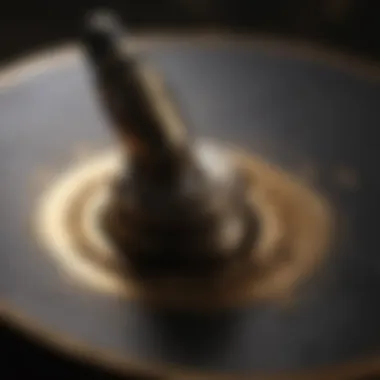Master the Art of Metal Polishing with a Dremel Tool for Professional Results


Metal polishing with a Dremel tool involves a meticulous process that can elevate your craft to professional levels. This comprehensive guide explores techniques, tips, and best practices, offering valuable insights for novices and experienced craftsmen alike. Whether you're looking to enhance your metalworking skills or achieve professional-grade results, this article provides a detailed overview of the intricate art of metal polishing with a Dremel.
Techniques and Tools
Utilizing the right techniques and tools is crucial when it comes to polishing metal with a Dremel. From understanding the various polishing attachments to mastering the correct speeds and pressure, every detail matters in achieving a flawless finish. This section will delve into the specific techniques and tools required for optimal results in metal polishing.
Surface Preparation
Before diving into the polishing process, proper surface preparation is key to ensuring a smooth and uniform finish. From cleaning the metal surface to sanding away imperfections, this step is essential for achieving professional-grade results. Readers will gain valuable insights into the importance of surface preparation and the techniques involved in priming metal surfaces for the polishing process.
Polishing Process
The actual polishing process involves a combination of skill, precision, and attention to detail. From selecting the right polishing compounds to understanding the correct polishing motions, this section will guide readers through the step-by-step process of polishing metal surfaces with a Dremel tool. Detailed explanations and tips will ensure that readers are equipped with the knowledge needed to master the art of metal polishing.
Tips for Achieving Professional Results
Elevating your metalworking skills to professional standards requires a deep understanding of techniques and attention to detail. This section will provide expert tips and best practices for achieving flawless results when polishing metal with a Dremel. From troubleshooting common issues to optimizing your polishing process, readers will learn invaluable tips for perfecting their craft.
Conclusion
Introduction to Metal Polishing
Metal polishing is a meticulous art that involves enhancing the appearance, durability, and precision finishes of various metal surfaces. In this comprehensive guide, we will delve into the intricate details of polishing metal using the versatile Dremel tool. Understanding the nuances of metal polishing is essential for both beginners and experienced craftsmen, as it can elevate the quality of finished products and unlock a world of creativity.
Understanding the Importance of Metal Polishing
Metal polishing plays a crucial role in enhancing aesthetics by transforming dull, rough surfaces into gleaming masterpieces. The process not only improves the visual appeal of metal objects but also increases their longevity by reducing the risk of corrosion and wear. Achieving precision finishes is another key aspect of metal polishing, ensuring that each project meets professional standards with smooth, flawless surfaces that impress even the most discerning eyes.
Enhancing Aesthetics
Enhancing aesthetics through metal polishing involves bringing out the natural shine and beauty of various metals, from stainless steel to brass. This process highlights the intricate details and textures of metal surfaces, creating visually stunning pieces that stand out in any collection. The key characteristic of enhancing aesthetics is its ability to add a touch of sophistication and elegance to ordinary objects, turning them into works of art.
Improving Durability
Improving durability is a critical benefit of metal polishing, as it not only enhances the appearance of metals but also protects them from environmental factors that can cause deterioration. By creating a barrier against moisture, dirt, and other elements, polished metal surfaces are better equipped to withstand daily use and maintain their pristine condition for years to come. The unique feature of improving durability through metal polishing is its sustainable impact, ensuring that objects remain functional and attractive over time.


Achieving Precision Finishes
Achieving precision finishes is essential for projects that require impeccable levels of detail and smoothness. Whether working on jewelry, tools, or decorative pieces, the precision attained through metal polishing sets a standard of excellence that defines craftsmanship. The advantage of precision finishes lies in the ability to elevate the overall quality of metalwork, creating surfaces that exhibit a level of care and skill that is truly impressive.
Overview of Dremel Tool
The Dremel tool serves as a versatile companion in the realm of metal polishing, offering a wide range of features and functions that streamline the polishing process. Understanding its capabilities and attachments is crucial for achieving professional results that meet your desired standards.
Features and Functions
The Dremel tool boasts a compact design and powerful motor that enables it to polish metal surfaces with precision and efficiency. Its variable speed settings and ergonomic grip provide control and comfort during extended use, making it an ideal choice for intricate polishing tasks. The unique feature of the Dremel tool is its compatibility with various attachments, allowing users to customize their polishing experience based on the project requirements.
Types of Attachments
From sanding drums to polishing wheels, the Dremel tool offers a diverse array of attachments that cater to different polishing needs. Each attachment is designed to address specific surface requirements, whether removing imperfections or achieving high-gloss finishes. The key characteristic of Dremel attachments is their versatility, allowing users to adapt their tool to various metal polishing techniques for optimal results.
Key Considerations
When using a Dremel tool for metal polishing, several key considerations come into play, such as safety precautions, maintenance tips, and project-specific requirements. Understanding how to operate the tool safely and effectively is paramount to achieving professional-grade results while prolonging the lifespan of the tool. Additionally, selecting the right attachments and polishing compounds is essential for optimizing the polishing process and ensuring consistent outcomes.
Preparation for Polishing
In this article, the section on Preparation for Polishing is crucial as it sets the foundation for achieving professional-grade results when polishing metal with a Dremel tool. Preparation plays a vital role in ensuring that the metal surface is ready for the polishing process. Key elements of Preparation for Polishing include selecting the right metal, understanding its surface characteristics, and thorough cleaning and degreasing. By focusing on these specific elements, crafters can optimize the efficiency and effectiveness of the metal polishing process.
Selecting the Right Metal
Choosing Appropriate Alloys
When it comes to Choosing Appropriate Alloys for metal polishing with a Dremel, the specific composition of the alloy can significantly impact the polishing outcome. Certain alloys are known for their exceptional durability, which is crucial for achieving long-lasting polished surfaces. The key characteristic of Choosing Appropriate Alloys lies in their ability to resist corrosion and maintain a high luster even after prolonged use. This makes them a popular choice among crafters looking to achieve professional results in metal polishing projects.
Understanding Surface Characteristics
Understanding Surface Characteristics is essential in metal polishing as it allows crafters to assess the condition of the metal before beginning the polishing process. By analyzing the surface characteristics, such as texture, porosity, and existing finishes, crafters can determine the best approach to achieve the desired polished result. While certain surfaces may require more intensive polishing techniques, others may benefit from gentle buffing, highlighting the importance of surface assessment in metal polishing projects.
Cleaning and Degreasing
Cleaning and Degreasing play a critical role in preparing the metal surface for polishing. Removing dirt, grease, and other contaminants ensures that the polishing process is carried out on a clean surface, maximizing the effectiveness of the polishing compounds and tools used. Crafters must pay attention to proper cleaning and degreasing techniques to avoid any residue that could affect the final polish. While cleaning and degreasing may seem like mundane tasks, their contribution to the overall polishing process should not be underestimated.


Setting Up Workspace
The section on Setting Up Workspace focuses on creating an optimal environment for metal polishing with a Dremel tool. Crafters are advised to establish a well-ventilated area to prevent the accumulation of dust and fumes during the polishing process. A well-ventilated workspace not only ensures the safety of the crafter but also aids in achieving consistent results by minimizing external factors that could affect the polishing outcome.
Creating a Well-Ventilated Area
Creating a Well-Ventilated Area is essential for maintaining a safe and comfortable workspace for metal polishing. Adequate ventilation helps dissipate any dust or fumes produced during the polishing process, keeping the air clean and breathable. This choice is beneficial as it promotes a healthy working environment and allows crafters to focus on their polishing tasks without concerns about air quality.
Securing Workpiece
Securing the workpiece is a critical aspect of setting up the workspace for metal polishing. By ensuring that the workpiece is stable and securely in place, crafters can avoid accidents and achieve precise polishing results. The key characteristic of securing the workpiece lies in its ability to withstand the pressure and movement involved in the polishing process, contributing to a smooth and controlled polishing experience.
Gathering Necessary Supplies
Gathering Necessary Supplies involves collecting all the tools and materials required for the metal polishing task. From polishing compounds to safety gear, having the right supplies on hand is essential for a seamless polishing process. Crafters should carefully consider the type of metal being polished and the specific requirements of the project when gathering supplies to ensure optimal results. This proactive approach minimizes interruptions during the polishing process and allows crafters to focus on achieving the desired finish efficiently.
Polishing Techniques with Dremel
Polishing techniques with a Dremel are a critical aspect of this article, offering in-depth insights into refining metal surfaces to a professional standard. Understanding the importance of perfecting polishing techniques is indispensable for achieving impeccable results. The meticulous process of grinding and sanding, followed by buffing and polishing, plays a pivotal role in transforming metal surfaces into masterpieces.
Grinding and Sanding
Choosing the Right Abrasives
When it comes to metal polishing with a Dremel, selecting the appropriate abrasives is paramount. The choice of abrasives directly impacts the efficiency and quality of the polishing process. Emphasizing the significance of choosing the right abrasives ensures optimal results. Different abrasives offer varying levels of abrasion and finish, allowing craftsmen to tailor their approach based on the metal type and desired outcome. Understanding the unique properties and compatibility of abrasives with different metals is essential for achieving the desired finish.
Executing Proper Techniques
Executing proper techniques during grinding and sanding stages is fundamental to the overall success of metal polishing. Precision and finesse in maneuvering the Dremel tool ensure even and consistent abrasion across the metal surface. Mastering the art of proper technique guarantees a smooth and refined finish, avoiding inconsistencies or damage to the metal. By adhering to best practices and utilizing the Dremel tool with expert skill, craftsmen can elevate their polishing results to a professional level.
Achieving Smooth Surfaces
Achieving smooth surfaces is the ultimate goal of grinding and sanding with a Dremel. The ability to remove imperfections, scratches, and blemishes from the metal surface requires attention to detail and a meticulous approach. By focusing on achieving a flawless finish, craftsmen can enhance the visual appeal and durability of the metal piece. Consistency in sanding techniques, coupled with the use of appropriate grit sizes, contributes to the attainment of silky-smooth surfaces that delight the eye and touch.
Buffing and Polishing


Selecting Suitable Buffing Compounds
Selecting the right buffing compounds is a crucial step in the polishing process with a Dremel. The choice of compounds influences the level of shine, protection, and clarity of the metal surface. By picking compounds tailored to the specific metal type and finish desired, craftsmen can amplify the luster and longevity of their polished pieces. Understanding the composition and application methods of different buffing compounds empowers craftsmen to achieve stunning results that rival professional polishing services.
Applying Correct Pressure
The application of correct pressure during buffing and polishing determines the outcome of the polishing process. Balancing pressure with the Dremel tool speed and compound consistency is vital for avoiding over or under-polishing the metal surface. By maintaining uniform pressure and adjusting techniques based on the metal's hardness and sensitivity, craftsmen can achieve a flawless shine without compromising the material's integrity. Consistency in pressure application guarantees a uniform finish across the entire surface, showcasing the craftsmanship and attention to detail.
Ensuring Consistent Results
Consistency is key to obtaining uniform and exceptional polishing results. Ensuring that each polishing session yields consistent outcomes involves meticulous attention to detail and adherence to established techniques. By monitoring progress, adjusting techniques as needed, and maintaining a steady hand throughout the buffing and polishing process, craftsmen can guarantee flawless results every time. Consistent results not only denote expertise but also reflect the mastery of metal polishing with a Dremel tool.
Finishing Touches and Maintenance
When it comes to the meticulous art of polishing metal with a Dremel, the finishing touches and maintenance play a crucial role in ensuring the longevity and quality of the final product. As the crowning steps of the process, these elements are what truly elevate the outcome from good to exceptional.
Cleaning and Inspection
Removing Residual Compounds
Even after the buffing and polishing stages, there may be residual compounds left on the surface of the metal. Removing these compounds is essential for achieving a clean, pristine finish. The specific aspect of removing residual compounds contributes significantly to the overall goal of perfecting the metal surface. Its key characteristic lies in its ability to eliminate any remaining debris and compounds, ensuring a smooth and flawless appearance. This step is popular for its effectiveness in achieving a professional-grade shine on the metal being worked on. The unique feature of this process is its meticulous nature, leaving no room for imperfections or unfinished details. While the advantages include a flawless final result, one should be cautious about potential abrasiveness on delicate metal surfaces.
Checking for Imperfections
Inspecting the polished metal for imperfections is a critical part of the process. This meticulous check ensures that no flaws are left unnoticed, guaranteeing a high-quality end product. The key characteristic of this step is the attention to detail and precision it demands, highlighting any areas that may require additional attention. It is a popular choice in metal polishing as it ensures a thorough evaluation of the work done so far. The unique feature lies in its ability to catch even the smallest imperfections, maintaining a standard of excellence. While the advantages include a flawless final output, one must be mindful of the time and scrutiny this step entails.
Ensuring Longevity
Preserving the polished metal's finish over time is paramount in ensuring its lasting beauty. The aspect of ensuring longevity contributes to the overall goal of maintaining the metal's shine and appearance for an extended period. Its key characteristic is its protective nature, creating a barrier against environmental factors that can tarnish the metal. This choice is popular for its ability to prolong the polished surface's aesthetic appeal. The unique feature of this practice is its capacity to protect against oxidation and wear, extending the metal's lifespan. While the advantages include a durable and long-lasting finish, one should be mindful of the maintenance required to uphold this longevity.
Protective Coatings
Choosing Appropriate Sealants
Selecting the right sealants for the metal surface is crucial in preserving its polished state. The choice of appropriate sealants contributes significantly to the overall goal of maintaining the metal's appearance. The key characteristic of these sealants is their protective properties, shielding the polished surface from corrosion and damage. This selection is popular as it enhances the durability of the polished metal, extending its lifespan. The unique feature of suitable sealants is their ability to provide a clear protective layer without compromising the shine of the metal. While the advantages include enhanced protection, one should consider the compatibility of the sealant with the metal type to avoid any adverse reactions.
Application Techniques
The way in which sealants are applied plays a crucial role in their effectiveness and longevity. Proper application techniques are essential in ensuring an even and thorough coverage of the metal surface. The key characteristic of these techniques is their precision and uniformity, guaranteeing a consistent protective layer. This choice is popular for its ability to enhance the sealant's functionality, maximizing its protective properties. The unique feature of correct application techniques is their capacity to prevent streaks or uneven coverage, maintaining the integrity of the sealant layer. While the advantages include a uniform protective coating, one should ensure proper ventilation and safety measures during application.
Preserving Shine
Preserving the shine of the polished metal is not just about aesthetics; it also reflects the care and attention given to the craft. The specific aspect of preserving shine contributes to the overall goal of maintaining the metal's luster and brilliance. Its key characteristic lies in its ability to protect the polished surface from dulling or fading over time, ensuring a lasting shine. This choice is popular for its ability to prolong the metal's reflective qualities, keeping it visually appealing. The unique feature of shine preservation techniques is their capacity to enhance the metal's visual impact without altering its appearance. While the advantages include a lasting glossy finish, one should be cautious of using abrasive cleaners that could damage the polished surface.







